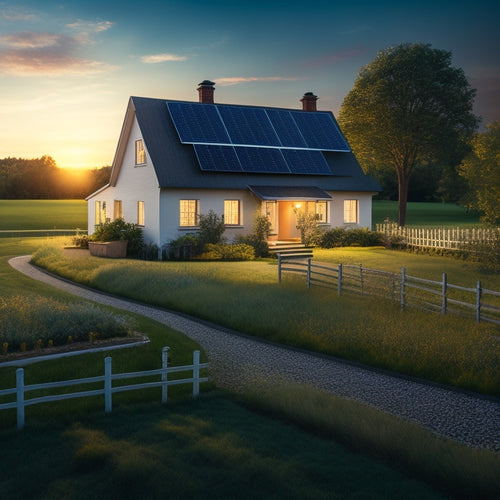
How Does a Solar Panel With a Built-In Inverter Work?
Share
You're considering a solar panel system with a built-in inverter, which means each solar panel has a small, high-efficiency inverter attached to it, converting DC power to AC power for home use. This microinverter system enables real-time monitoring and control of each panel's performance, optimizing energy production even in partial shading conditions. The inverter tracks the maximum power point to extract the most energy from each panel, achieving an efficiency of 95% to 98%. With built-in inverters, you'll experience increased energy efficiency, reduced reliance on the grid, and easier maintenance. Now that you know the basics, you're ready to investigate the full potential of this innovative technology.
Key Takeaways
- A solar panel with a built-in inverter converts DC power from the panel to AC power for home use, eliminating the need for a separate inverter unit.
- The built-in inverter optimizes energy production by tracking the maximum power point and adjusting voltage and current to match the ideal operating point.
- Real-time monitoring and control of each panel's performance enable the detection of anomalies and underperformance, ensuring maximum energy harvesting.
- The built-in inverter synchronizes the AC output with the grid's frequency and voltage, allowing excess energy to be fed back into the grid.
- The system continuously monitors grid conditions to ensure safe power transfer and optimizes output for maximum energy yield.
What Is a Microinverter System?
In a solar panel system, each panel produces DC power, but homes and businesses require AC power to function. To bridge this gap, you'll need a system that can convert DC power to AC. This is where microinverter technology comes in.
A microinverter system is a type of solar panel system that uses small, high-efficiency inverters attached to each individual solar panel. This allows each panel to operate independently, maximizing panel efficiency and overall system performance.
With a microinverter system, you can monitor and control each panel's performance in real-time, identifying any issues quickly and easily. This level of granularity is particularly useful in systems with multiple panels, as it guarantees that each panel is operating at its maximum potential.
Additionally, microinverters can optimize energy production for each panel, even in partial shading conditions, further increasing overall system efficiency. By leveraging microinverter technology, you can reveal the full potential of your solar panel system, assuring maximum energy production and a faster return on investment.
How Does the Inverter Work?
Now that you've chosen a microinverter system for your solar panel setup, you're likely wondering how the inverter itself works its magic. The inverter is the brain of your solar panel system, responsible for converting the DC power generated by your solar panels into AC power that's usable in your home.
There are several inverter types, including string inverters, central inverters, and microinverters. Microinverters, like the one in your system, are installed underneath each solar panel to optimize energy production at the individual panel level.
The inverter's primary function is to maximize energy harvest while ensuring a safe and efficient conversion process. It does this by tracking the maximum power point of each solar panel and adjusting the output voltage and current accordingly. This results in higher inverter efficiency, typically ranging from 95% to 98%.
The inverter also provides real-time monitoring and control capabilities, allowing you to track your energy production and identify any potential issues. By optimizing energy production and ensuring efficient conversion, your microinverter system is able to generate more power and reduce your reliance on the grid.
Benefits of Built-In Inverters
With your microinverter system in place, you're reaping the benefits of optimized energy production at the individual panel level. This setup guarantees that each panel operates at its maximum potential, resulting in increased energy efficiency. By converting DC power to AC power at the panel level, you're minimizing energy losses and maximizing your system's overall output.
Here's a breakdown of the key benefits:
| Benefit | Description |
|---|---|
| Energy Efficiency | Optimized energy production at the individual panel level reduces energy losses and increases overall system output. |
| System Longevity | Built-in inverters reduce the risk of system failure by minimizing the stress on individual components. |
| Easier Maintenance | With each panel operating independently, identifying and replacing faulty components becomes a simpler task. |
| Enhanced Monitoring | Built-in inverters enable real-time monitoring of each panel's performance, allowing for swift issue detection and resolution. |
AC Power Generation Process
You're now looking at the AC power generation process, where the inverter converts DC power from the solar panels into usable AC power for your home or business.
This process involves grid-tie energy conversion, which synchronizes the inverter's output with the grid's frequency and voltage.
Additionally, the inverter's max power point tracking (MPPT) function guarantees that it extracts the maximum amount of power from the solar panels, even as the sun's intensity changes.
Grid-Tie Energy Conversion
The AC power generation process begins when sunlight hits the photovoltaic (PV) cells in your solar panel array, exciting electrons that flow through an inverter. This inverter converts the DC power generated by your solar panels into AC power, which is usable in your home or business.
In a grid-tie system, the inverter is designed to synchronize its AC output with the grid's AC waveform. This allows you to feed excess energy back into the grid through a grid connection, offsetting your energy consumption and increasing your energy efficiency.
The inverter continuously monitors the grid's voltage and frequency, ensuring a safe and efficient transfer of power. When the grid is unavailable, the inverter will shut down to prevent backfeeding electricity into the grid, a safety feature required by utility companies.
During normal operation, the inverter will optimize its output to match the grid's voltage and frequency, ensuring maximum energy harvesting and efficient transmission to the grid. This synchronization enables you to maximize your energy production and reduce your reliance on the grid.
Max Power Point Tracking
As your solar panel array generates DC power, the inverter's Max Power Point Tracking (MPPT) function kicks in, ensuring you extract the maximum amount of energy from your solar panels. This advanced technology continuously monitors the voltage and current output of your solar panels, identifying the ideal operating point to maximize energy production.
By doing so, MPPT enhances solar efficiency, allowing you to generate more power from the same solar panel array. The MPPT algorithm rapidly adjusts the operating voltage and current to match the maximum power point, ensuring energy optimization under varying environmental conditions.
This results in higher energy yields, even on cloudy or partially shaded days. The inverter's MPPT function is essential in maximizing your solar panel system's overall performance, as it enables you to generate more power and reduce energy losses.
Advantages Over Traditional Systems
You'll find that solar panels with inverters offer several advantages over traditional systems.
For one, the installation process is simplified, reducing the need for complex wiring and infrastructure.
This, in turn, leads to reduced system costs and improved energy yield.
Simplified Installation Process
Streamline your solar panel installation with inverter-integrated systems, which eliminate the need for a centralized inverter unit. This design change simplifies the entire installation process, making it more efficient and reducing the risk of errors.
With an inverter-integrated system, you'll have fewer components to connect, resulting in a faster and easier setup. This user-friendly design allows you to focus on getting your system up and running quickly, rather than spending hours wiring and configuring multiple components.
The simplified installation process also reduces the need for specialized labor, as the inverter is already built into the panel. This means you can save time and money on installation costs, and get your system generating power sooner.
Additionally, the integrated design makes it easier to monitor and maintain your system, as all the components are housed in a single unit. With an inverter-integrated system, you can enjoy the benefits of solar power without the hassle of complex installations.
Reduced System Costs
Fewer components mean lower upfront costs for your solar panel system. With a built-in inverter, you eliminate the need for a separate inverter unit, which reduces the overall cost of your solar panel system. This cost efficiency is achieved through system optimization, where the inverter is specifically designed to work in tandem with the solar panel, resulting in a more streamlined and efficient system.
In addition, the reduced number of components means fewer potential failure points, which translates to lower maintenance costs over the system's lifespan.
You'll also benefit from reduced installation costs, as the built-in inverter simplifies the installation process and requires less labor. Moreover, the compact design of the solar panel with a built-in inverter reduces the required installation space, making it ideal for smaller rooftops or areas with limited space.
Improved Energy Yield
Your solar panel system's energy yield improves markedly with a built-in inverter, surpassing the performance of traditional systems in several ways.
For one, individual panel optimization guarantees that each panel operates at its maximum potential, without being dragged down by underperforming panels in the array. This results in higher solar efficiency and more energy harvested per hour of sunlight.
Additionally, built-in inverters enable real-time energy optimization, allowing your system to adapt to changing environmental conditions like temperature and shading.
This adaptable optimization guarantees that your system consistently produces more power than traditional systems, which often struggle to maintain peak performance. By minimizing energy losses and maximizing energy production, solar panels with built-in inverters can increase your overall energy yield by up to 25%.
This translates to more power for your home or business, and a faster return on your investment. With improved energy yield, you can enjoy the benefits of renewable energy while minimizing your reliance on the grid.
Installation and Maintenance Tips
Properly installing and maintaining your solar panel system with an inverter is vital to guarantee peak performance and longevity. You'll want to ascertain that your system is installed at the ideal angle and direction to maximize energy yield. Additionally, keeping your panels clean and free of debris is essential to maintaining their efficiency.
Here's a breakdown of some key installation techniques and maintenance practices to keep in mind:
| Installation Techniques | Maintenance Practices |
|---|---|
| Install at ideal angle | Clean panels regularly |
| Ascertain proper grounding | Check for loose connections |
| Use weather-resistant materials | Perform inverter firmware updates |
| Consider installing a monitoring system | Schedule annual inspections |
| Ascertain compliance with local building codes | Keep vegetation trimmed around panels |
Monitoring and Tracking Performance
In tandem with optimizing your solar panel system's performance, monitoring and tracking its energy production is crucial to identify potential issues, maximize energy yield, and assure a strong return on investment.
By keeping a close eye on your system's performance, you can detect any anomalies or underperformance, and take corrective action to guarantee your system operates at peak energy efficiency.
You can monitor your system's performance through:
-
Web-based monitoring platforms: These platforms provide real-time data on your system's energy production, allowing you to track your energy yield and identify any issues remotely.
-
Mobile apps: Many solar panel systems come with mobile apps that enable you to monitor your system's performance on-the-go.
-
Inverter displays: Some inverters come equipped with built-in displays that show real-time data on your system's energy production.
Frequently Asked Questions
Can a Solar Panel With a Built-In Inverter Be Used for Grid-Tie Systems?
You can use a solar panel with a built-in inverter for grid-tie systems, optimizing solar panel integration and inverter efficiency, but make certain the inverter meets grid-tie standards and is certified for your region's grid requirements.
Are Built-In Inverters Compatible With Energy Storage Systems?
You'll find that built-in inverters can seamlessly integrate with energy storage systems, optimizing energy efficiency during the installation process, allowing you to maximize your power output and store excess energy for later use.
How Do I Troubleshoot Issues With a Built-In Inverter?
Did you know 80% of solar panel issues stem from inverter problems? You'll likely encounter common issues like DC oversupply, grid faults, or communication errors; to troubleshoot, check inverter display codes, review system monitoring data, and consult the manufacturer's guide for specific troubleshooting tips.
Can I Upgrade or Replace a Built-In Inverter in the Future?
You can upgrade or replace a built-in inverter in the future, but it's essential to take into account inverter longevity and compatibility with future upgrades, ensuring seamless integration and maximum power output.
Are Built-In Inverters More Prone to Overheating Than Traditional Inverters?
As you gaze at the sleek solar panel, you wonder if the built-in inverter is a heat-prone ticking time bomb. Unfortunately, yes, it's more susceptible to overheating due to compromised heat dissipation, which can reduce inverter efficiency and overall system performance.
Conclusion
You've now grasped the ins and outs of solar panels with built-in inverters. These innovative systems simplify the process of utilizing solar energy, making it more efficient and convenient. Did you know that, according to the International Energy Agency, solar power could become the largest source of electricity globally by mid-century, with inverters playing an essential role in this change? As the technology continues to advance, it's exciting to think about the possibilities that lie ahead.
Related Posts
-

Evaluating Solar Power Options for Businesses
Evaluating solar power options for your business can greatly reduce energy costs and enhance sustainability. Start by...
-

Energy-Efficient Lighting Solutions for Sustainable Buildings
For sustainable buildings, energy-efficient lighting solutions, like LEDs, offer multiple benefits. These bulbs last ...
-

Cost-Effective Solar Solutions for Rural Homes
Cost-effective solar solutions can alter your rural home by enhancing energy independence and slashing utility bills....


